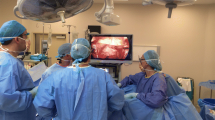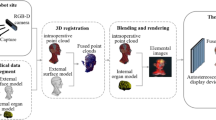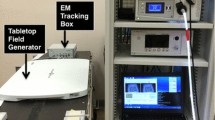Abstract
Purpose:
Autostereoscopic 3D visualization (ASV) forms a potentially appealing alternative to stereoscopic 3D displays to help surgeons regain depth perception during minimally invasive surgery (MIS). However, the feasibility of using single-viewer ASV has not yet been demonstrated in a clinical context. The purpose of the study is to analyze the current surgical workflow and display usage and assess the potential for using ASV in MIS applications. Additionally, the study seeks to acquire a better understanding of key design requirements, such as the eye-tracking performance and the lenticular lens 3D workspace.
Methods:
Two types of gynecologic interventions were investigated. A vision-based tracking system was developed, consisting of depth cameras mounted on the displays and ArUco markers placed on the hair caps of clinicians and the wall of the operating room. This allowed simultaneous tracking of the pose of operating staff and displays.
Results:
Overall 20 surgeries were recorded, where 4 clinicians operated using 3 displays. Users were typically standing at a mean distance of 1900 mm in a range from to 1200 to 2300 mm from the display. Left–right motion was from − 600 to 658 mm. Clinicians stood on average 1000 mm from each other. The head roll angle was below 16\(^\circ \).
Conclusion:
Surgeons were looking predominantly (99%) to the same display. Observations took place from fairly well-defined places and with sufficient potential to differentiate between clinicians, suggesting that single-viewer ASV would be feasible.





Similar content being viewed by others
References
Bogdanova R, Boulanger P, Zheng B (2016) Depth perception of surgeons in minimally invasive surgery. Surg Innov 23(5):515–524. https://doi.org/10.1177/1553350616639141
Gómez-Gómez E, Carrasco-Valiente J, Valero-Rosa J, Campos-Hernández JP, Anglada-Curado FJ, Carazo-Carazo JL, Font-Ugalde P, Requena-Tapia MJ (2015) Impacto de la visión 3D sobre la carga mental y el rendimiento laparoscópico en individuos sin experiencia. Actas Urológicas Españolas 39(4):229–235. https://doi.org/10.1016/J.ACURO.2014.09.008
Vickers AJ, Savage CJ, Hruza M, Tuerk I, Koenig P, Martínez-Piñeiro L, Janetschek G, Guillonneau B (2009) The surgical learning curve for laparoscopic radical prostatectomy: a retrospective cohort study. Lancet Oncol 10(5):475–480. https://doi.org/10.1016/S1470-2045(09)70079-8
Yim A (2017) Title three-dimensional laparoscopy: is it as good as it looks?-a review of the literature. https://doi.org/10.21037/ales.2017.08.01
Arezzo A, Vettoretto N, Francis NK, Bonino MA, Curtis NJ, Amparore D, Arolfo S, Barberio M, Boni L, Brodie R, Bouvy N, Cassinotti E, Carus T, Checcucci E, Custers P, Diana M, Jansen M, Jaspers J, Marom G, Momose K, Müller-Stich BP, Nakajima K, Nickel F, Perretta S, Porpiglia F, Sánchez-Margallo F, Sánchez-Margallo JA, Schijven M, Silecchia G, Passera R, Mintz Y (2018) The use of 3D laparoscopic imaging systems in surgery: EAES consensus development conference 2018. Surgical Endoscopy 2018 33:10 33(10), 3251–3274 . https://doi.org/10.1007/S00464-018-06612-X
Urey H, Chellappan KV, Erden E, Surman P (2011) State of the art in stereoscopic and autostereoscopic displays. Proc IEEE 99(4):540–555. https://doi.org/10.1109/JPROC.2010.2098351
Chen C-Y, Yang T-T, Sun W-S (2008) Optics system design applying a micro-prism array of a single lens stereo image pair. Opt Express 16(20):15495–15505. https://doi.org/10.1364/OE.16.015495
Liu J, Cui F, Li J, Shao W, Wang W, Li J, Liu M, He J (2018) Development and clinical applications of glasses-free three-dimensional (3D) display technology for thoracoscopic surgery. Ann Transl Med 6(11):214. https://doi.org/10.21037/ATM.2018.05.44
Aznar-Casanova JA, Romeo A, Gómez AT, Enrile PM (2016) Visual fatigue while watching 3D stimuli from different positions. J Optom 10(3):149–160. https://doi.org/10.1016/J.OPTOM.2016.07.002
Xiao Y, Schimpff S, Mackenzie C, Merrell R, Entin E, Voigt R, Jarrell B (2007) Video Technology to Advance Safety in the Operating Room and Perioperative Environment. Surg Innov 14:52–61
Azevedo-Coste C, Pissard-Gibollet R, Toupet G, Fleury É, Lucet JC, Birgand G (2019) Tracking Clinical Staff Behaviors in an Operating Room. Sensors (Basel, Switzerland) 19(10):1–14. https://doi.org/10.3390/s19102287
Stenmark M, Omerbašić E, Magnusson M, Andersson V, Abrahamsson M, Tran P-K (2022) Vision-based tracking of surgical motion during live open-heart surgery. J Surg Res 271:106–116. https://doi.org/10.1016/J.JSS.2021.10.025
Birgand G, Azevedo C, Rukly S, Pissard-Gibollet R, Toupet G, Timsit JF, Lucet JC (2019) Motion-capture system to assess intraoperative staff movements and door openings: impact on surrogates of the infectious risk in surgery. Infect Control Hosp Epidemiol 40(5):566–573. https://doi.org/10.1017/ICE.2019.35/
Guest G, Namey E, Chen M (2020) A simple method to assess and report thematic saturation in qualitative research. PLoS ONE 15(5):1–17. https://doi.org/10.1371/journal.pone.0232076
Garrido-Jurado S, Muñoz-Salinas R, Madrid-Cuevas FJ, Marín-Jiménez MJ (2014) Automatic generation and detection of highly reliable fiducial markers under occlusion. Pattern Recogn 47(6):2280–2292. https://doi.org/10.1016/J.PATCOG.2014.01.005
Fernández A, Usamentiaga R, Carús JL, Casado R (2016) Driver distraction using visual-based sensors and algorithms. Sensors (Switzerland) 16(11):1805. https://doi.org/10.3390/S16111805
Li W, Dong Q, Jia H, Zhao S, Wang Y, Xie L, Pan Q, Duan F, Liu T (2019) Training a camera to perform long-distance eye tracking by another eye-tracker. IEEE Access 7:155313–155324. https://doi.org/10.1109/ACCESS.2019.2949150
Knorr S, Ide K, Kunter M, Sikora T (2012) The avoidance of visual discomfort and basic rules for producing good 3d pictures. SMPTE Motion Imaging J 121:72–79. https://doi.org/10.5594/j18236
Sun G, Liu W, Fraser D, Zhang Y (2021) A possible predictor of visual discomfort of viewing stereoscopic 3d maps: the imbalance of disparity distributions. Proc Hum Factors Ergon Soc Ann Meet 65(1):1432–1436. https://doi.org/10.1177/1071181321651199
Shibata T, Kim J, Hoffman D, Banks M (2011) The zone of comfort: Predicting visual discomfort with stereo displays. J Vision 11:11. https://doi.org/10.1167/11.8.11
Williams SP, Parrish RV (1990) New computational control techniques and increased understanding for stereo 3-D displays. Stereoscopic displays and applications. Int Soc Opt Photon 1256:73–82. https://doi.org/10.1117/12.19891
Surgical table brand comparison chart. https://avantehs.com/learn/buying-guides/surgical-table-brand-comparison Accessed 31 May 2022
Principles of Room Setup and Port Placement for Minimally Invasive Surgery, Atlas of Minimally Invasive Surgical Operations, AccessSurgery, McGraw Hill Medical. https://accesssurgery.mhmedical.com/content.aspx?bookid=2403 §ionid=187823380 Accessed 31 May 2022
Funding
This research was funded by Agentschap Innoveren en Ondernemen, Belgium, with grant number HBC.2020.2246.
Author information
Authors and Affiliations
Corresponding author
Ethics declarations
Ethical approval
The study was approved by the Ethical Committee of University Hospital Leuven, Belgium with study number S65658.
Informed consent
Informed consent was obtained from all individual participants included in the study.
Additional information
Publisher's Note
Springer Nature remains neutral with regard to jurisdictional claims in published maps and institutional affiliations.
Rights and permissions
Springer Nature or its licensor holds exclusive rights to this article under a publishing agreement with the author(s) or other rightsholder(s); author self-archiving of the accepted manuscript version of this article is solely governed by the terms of such publishing agreement and applicable law.
About this article
Cite this article
Vörös, V., Page, AS., Deprest, J. et al. Motion and viewing analysis during minimally invasive surgery for autostereoscopic visualization. Int J CARS 18, 527–535 (2023). https://doi.org/10.1007/s11548-022-02753-6
Received:
Accepted:
Published:
Issue Date:
DOI: https://doi.org/10.1007/s11548-022-02753-6




